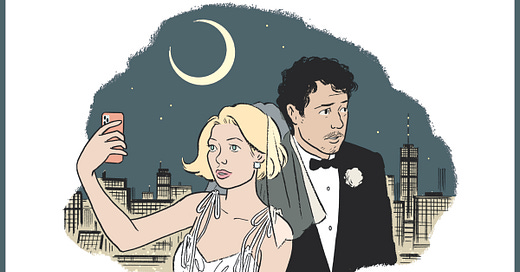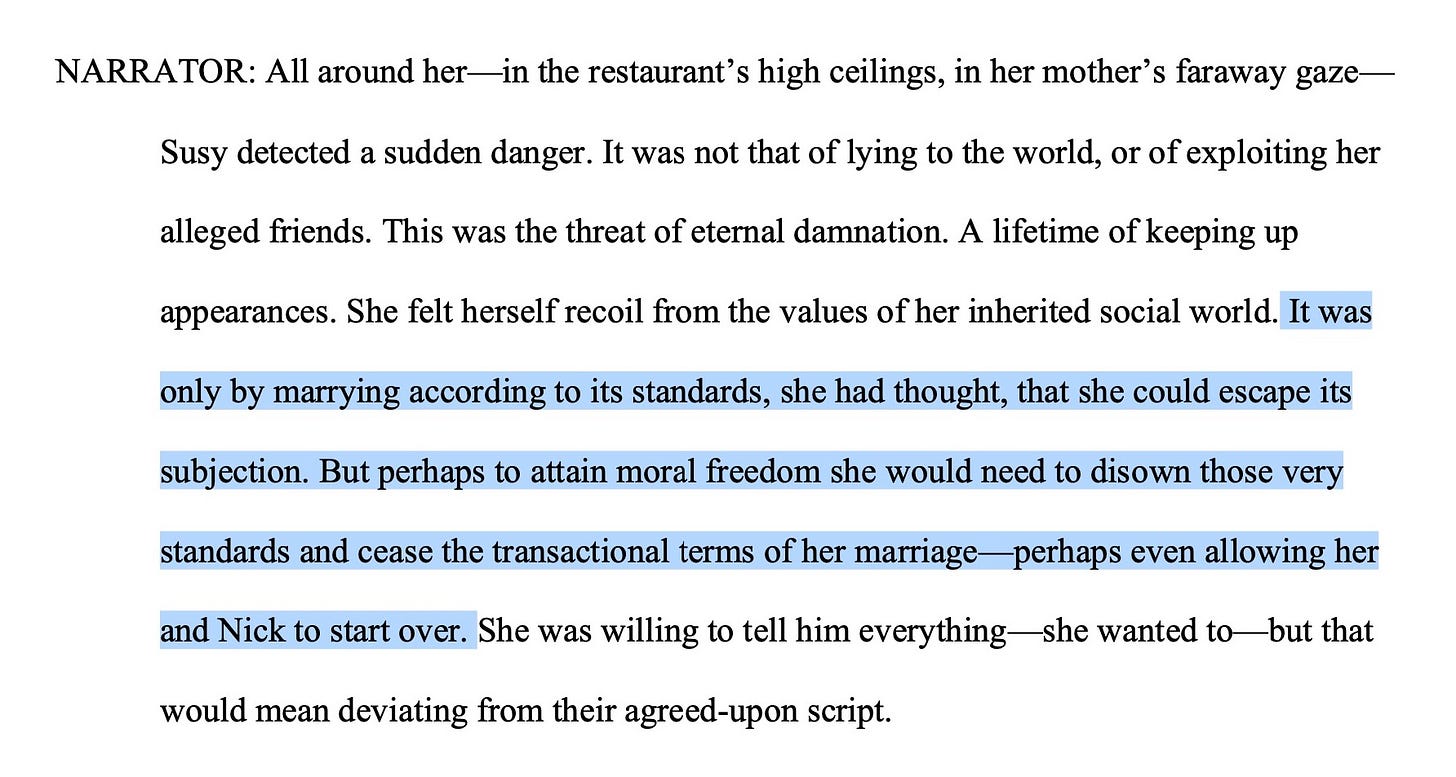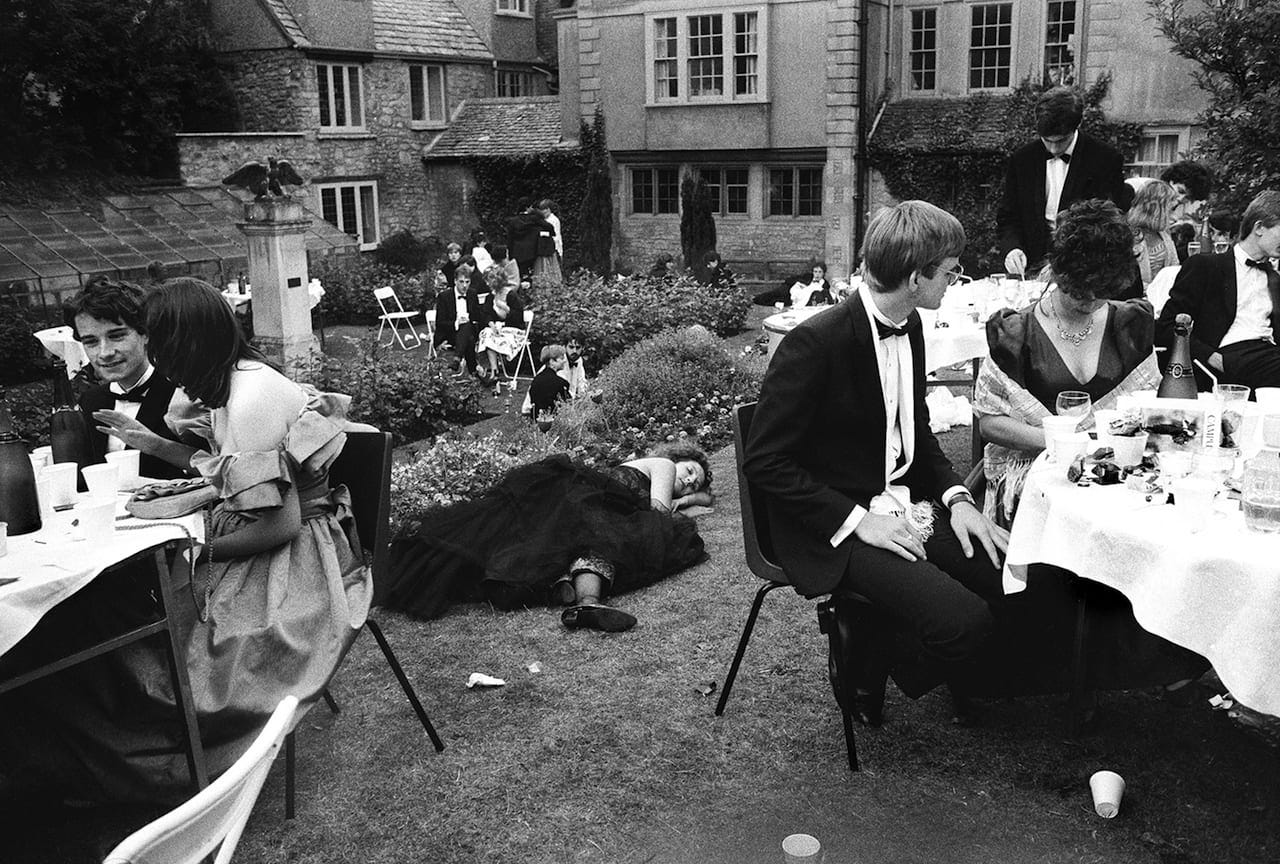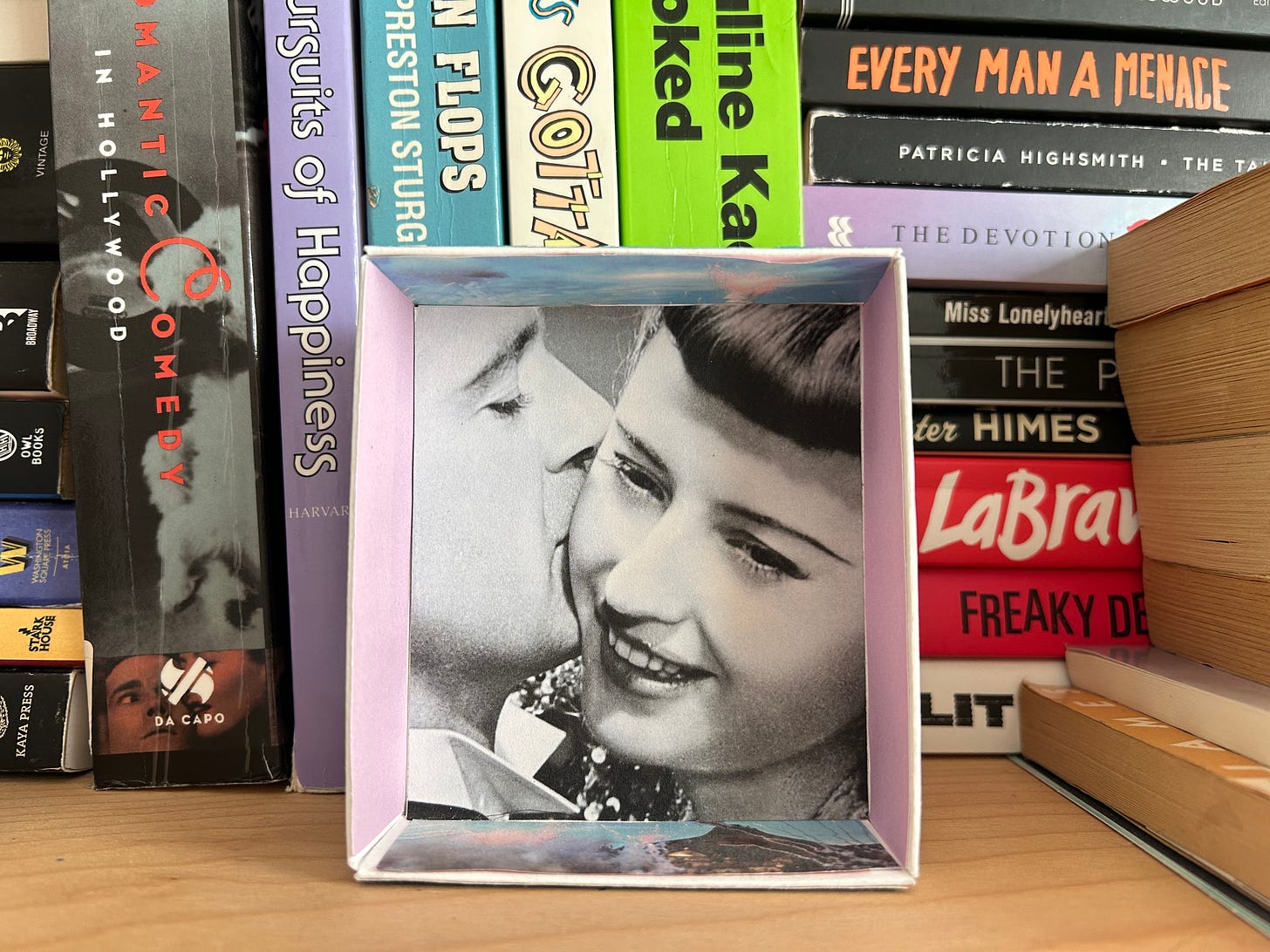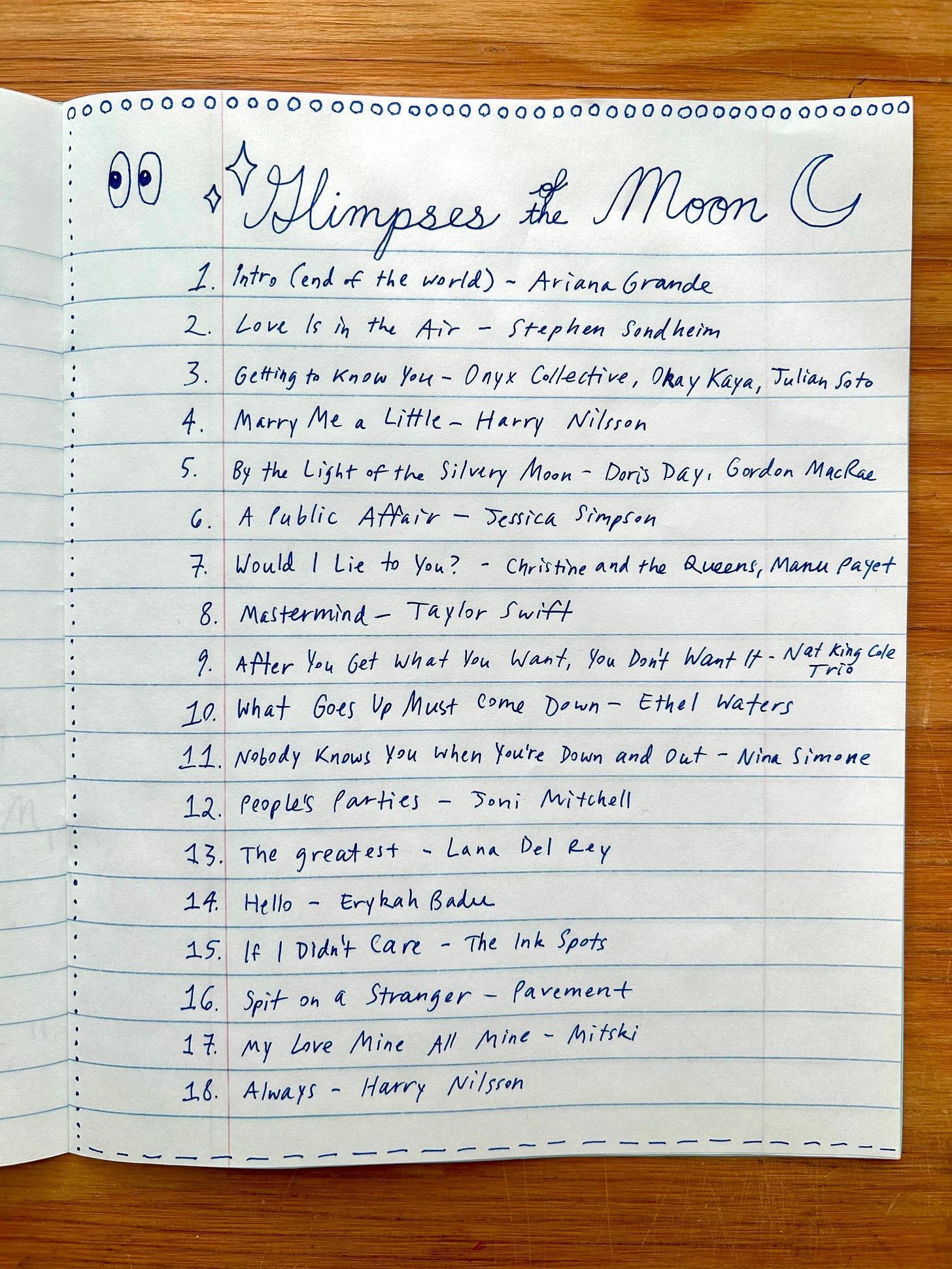Extra, extra…LISTEN all about it? :-o
I’m writing to share Glimpses of the Moon, an Audible Original I wrote and directed with Sam Freilich and performed opposite Adam Dimarco. It’s based on Edith Wharton’s 1922 novel about a couple who get married for cash, gifts, and clout, with the understanding that they can always marry up if either meets someone of a higher status. Our series takes place in 2021, with the couple also becoming influencers, adding sponcon and personal branding to marriage’s list of perks. They also appreciate being able to prolong having (they think) real jobs or feelings or relationships. What could go wrong!!!
Sam got the idea five years ago after reading the book, which is incredibly romantic, satirical, contemporary, cinematic, with hijinks. When I read it I felt especially taken with its elegant depictions of the superstructures of power that architect even the most intimate interactions. Put more plainly, it hurt my heart. Wharton’s psychological acuity makes it both a biting satire and a tender romance. The narrator sees right through a character in one sentence, and sees their deepest wound the next. I’ll be the first to say it: Edith Wharton’s books are good. Yeah, I went there!
When Sam had this idea I was already writing and reading quite a bit about Instagram, scammers, and the ways in which the intangible currencies of access and visibility make me feel like a scammer. We were both fascinated that marriage doesn’t really mean as much now as it did then, yet weddings seem to mean more—at least for the Glimpses milieu. Also fascinated by the newer ways one can perform or monetize their personal relationships. Blah blah blah. I could go on but it was more fun to explore this dramatically with Sam. Plus it gave me a great outlet for squirreled-away dialogue from my adventures in fashion and media. Then producing and directing it with people (!!!) was truly joyful. Now that it’s out I wanted to compile our references and memories in one place.
Writing
If you love a book, adapting it is a really cool way to feel even closer to it…not just studying it but saving whatever will feed your imagination. There’s that Rebecca Solnit line: “The object we call a book is not the real book, but its potential, like a musical score or seed.” It was so nice to have to follow those fleeting mental images, and now I can look back and see what we underlined and then butchered. I don’t suggest anyone put their writing next to Edith Wharton’s, but in the interest of radical vulnerability:
In 2023 we visited Wharton’s home, The Mount. Favorite details:
![1: Informational display titled "The Nature of Houses" with text and decorative motifs. Transcribed Text: The Nature of Houses In her fiction Wharton often drew parallels between houses and human character, most notably in her 1892 short story, "The Fulness of Life": "I have sometimes thought that a woman’s nature is like a great house full of rooms: there is the hall, through which everyone passes; the drawing room, where one receives formal visits; the sitting room, where the members of the family come and go . . . but beyond that, are other rooms, the handles of whose doors are never turned; no one knows the way to them, no one knows whither they lead; and in the innermost room, the holy of holies, the soul sits alone and waits for a footstep that never comes." She later critiqued this semi-autobiographical depiction of a soul in pain as "one long shriek [written] at the top of my voice." 2: Elegant library with dark wood and floor-to-ceiling bookshelves, ornate decorative features, antique furniture, and large windows. 3: Framed image of Edith Wharton sitting at a desk with a text quote beside her portrait. Transcribed Text: Edith Wharton staged publicity photos to give the impression she wrote at a desk, but she really did most of her writing in bed: “She would have her writing board perilously furnished with an ink-pot on her knee, the dog of the moment under her left elbow and the bed strewn with correspondence, newspapers and books.” Gaillard Lapsley (1871-1949), friend of Edith Wharton. 4: Picture of an elegant dining room with a round table covered by a white tablecloth, set with crystal glasses and candlesticks. The floor is carpeted in a beige, woven pattern. Under the table, a small, fluffy dog with long hair is lying on a leopard-print cushion. 5: Weathered gravestone in a forest with the inscription "Our Sweetheart Modele, Died Jan 5 1914." 6: Poster with a photo of an interior hallway and text about the purpose of doors. Transcribed Text: Above all, privacy For Wharton, doors created privacy as well as beauty. Inspired by European houses, the main floor of The Mount is in a style called enfilade. All rooms open up to the next room and doors are lined up to allow vistas from one room to another. “…the main purpose of a door is to admit, its secondary purpose is to exclude.” Edith Wharton, The Decoration of Houses, 1897 7: Photograph depicting white and pink flowers, which circle around a small man-made pond. In the background, a manicured garden is visible. 8: An open spiral notebook with handwritten notes on the right page. Transcribed Text: YES AGREE! More fake dogs please! yes ma'am! yess! please!! Edith has such a slay style! Love her work in both design, art & literature! ~ Kloey More fake dogs plz! ❤️[heart] 9: Text on a beige wall about Edith Wharton's writing style. Near the left side, the text reads, "The innermost room..." in a larger, bold serif font. Below this, there is a paragraph in a smaller, sans-serif font describing the writing style of Edith Wharton. Transcribed Text: "The innermost room..." Edith Wharton did not write happy endings. Her stories feature the lost chance; her characters yearn for someone to join them in that innermost room of the soul. Whether Wharton achieved that in her own life, and with whom, is a story as mysterious and captivating as any of her fiction.](https://substackcdn.com/image/fetch/$s_!4zEK!,w_474,c_limit,f_auto,q_auto:good,fl_progressive:steep/https%3A%2F%2Fsubstack-post-media.s3.amazonaws.com%2Fpublic%2Fimages%2Fd4ee1892-3f63-46f5-8a62-7382d9bc5254_3024x4032.heic)
![1: Informational display titled "The Nature of Houses" with text and decorative motifs. Transcribed Text: The Nature of Houses In her fiction Wharton often drew parallels between houses and human character, most notably in her 1892 short story, "The Fulness of Life": "I have sometimes thought that a woman’s nature is like a great house full of rooms: there is the hall, through which everyone passes; the drawing room, where one receives formal visits; the sitting room, where the members of the family come and go . . . but beyond that, are other rooms, the handles of whose doors are never turned; no one knows the way to them, no one knows whither they lead; and in the innermost room, the holy of holies, the soul sits alone and waits for a footstep that never comes." She later critiqued this semi-autobiographical depiction of a soul in pain as "one long shriek [written] at the top of my voice." 2: Elegant library with dark wood and floor-to-ceiling bookshelves, ornate decorative features, antique furniture, and large windows. 3: Framed image of Edith Wharton sitting at a desk with a text quote beside her portrait. Transcribed Text: Edith Wharton staged publicity photos to give the impression she wrote at a desk, but she really did most of her writing in bed: “She would have her writing board perilously furnished with an ink-pot on her knee, the dog of the moment under her left elbow and the bed strewn with correspondence, newspapers and books.” Gaillard Lapsley (1871-1949), friend of Edith Wharton. 4: Picture of an elegant dining room with a round table covered by a white tablecloth, set with crystal glasses and candlesticks. The floor is carpeted in a beige, woven pattern. Under the table, a small, fluffy dog with long hair is lying on a leopard-print cushion. 5: Weathered gravestone in a forest with the inscription "Our Sweetheart Modele, Died Jan 5 1914." 6: Poster with a photo of an interior hallway and text about the purpose of doors. Transcribed Text: Above all, privacy For Wharton, doors created privacy as well as beauty. Inspired by European houses, the main floor of The Mount is in a style called enfilade. All rooms open up to the next room and doors are lined up to allow vistas from one room to another. “…the main purpose of a door is to admit, its secondary purpose is to exclude.” Edith Wharton, The Decoration of Houses, 1897 7: Photograph depicting white and pink flowers, which circle around a small man-made pond. In the background, a manicured garden is visible. 8: An open spiral notebook with handwritten notes on the right page. Transcribed Text: YES AGREE! More fake dogs please! yes ma'am! yess! please!! Edith has such a slay style! Love her work in both design, art & literature! ~ Kloey More fake dogs plz! ❤️[heart] 9: Text on a beige wall about Edith Wharton's writing style. Near the left side, the text reads, "The innermost room..." in a larger, bold serif font. Below this, there is a paragraph in a smaller, sans-serif font describing the writing style of Edith Wharton. Transcribed Text: "The innermost room..." Edith Wharton did not write happy endings. Her stories feature the lost chance; her characters yearn for someone to join them in that innermost room of the soul. Whether Wharton achieved that in her own life, and with whom, is a story as mysterious and captivating as any of her fiction.](https://substackcdn.com/image/fetch/$s_!UMfq!,w_474,c_limit,f_auto,q_auto:good,fl_progressive:steep/https%3A%2F%2Fsubstack-post-media.s3.amazonaws.com%2Fpublic%2Fimages%2F0eddee84-283f-408a-bf6c-ff46f2a8f844_4032x3024.heic)
![1: Informational display titled "The Nature of Houses" with text and decorative motifs. Transcribed Text: The Nature of Houses In her fiction Wharton often drew parallels between houses and human character, most notably in her 1892 short story, "The Fulness of Life": "I have sometimes thought that a woman’s nature is like a great house full of rooms: there is the hall, through which everyone passes; the drawing room, where one receives formal visits; the sitting room, where the members of the family come and go . . . but beyond that, are other rooms, the handles of whose doors are never turned; no one knows the way to them, no one knows whither they lead; and in the innermost room, the holy of holies, the soul sits alone and waits for a footstep that never comes." She later critiqued this semi-autobiographical depiction of a soul in pain as "one long shriek [written] at the top of my voice." 2: Elegant library with dark wood and floor-to-ceiling bookshelves, ornate decorative features, antique furniture, and large windows. 3: Framed image of Edith Wharton sitting at a desk with a text quote beside her portrait. Transcribed Text: Edith Wharton staged publicity photos to give the impression she wrote at a desk, but she really did most of her writing in bed: “She would have her writing board perilously furnished with an ink-pot on her knee, the dog of the moment under her left elbow and the bed strewn with correspondence, newspapers and books.” Gaillard Lapsley (1871-1949), friend of Edith Wharton. 4: Picture of an elegant dining room with a round table covered by a white tablecloth, set with crystal glasses and candlesticks. The floor is carpeted in a beige, woven pattern. Under the table, a small, fluffy dog with long hair is lying on a leopard-print cushion. 5: Weathered gravestone in a forest with the inscription "Our Sweetheart Modele, Died Jan 5 1914." 6: Poster with a photo of an interior hallway and text about the purpose of doors. Transcribed Text: Above all, privacy For Wharton, doors created privacy as well as beauty. Inspired by European houses, the main floor of The Mount is in a style called enfilade. All rooms open up to the next room and doors are lined up to allow vistas from one room to another. “…the main purpose of a door is to admit, its secondary purpose is to exclude.” Edith Wharton, The Decoration of Houses, 1897 7: Photograph depicting white and pink flowers, which circle around a small man-made pond. In the background, a manicured garden is visible. 8: An open spiral notebook with handwritten notes on the right page. Transcribed Text: YES AGREE! More fake dogs please! yes ma'am! yess! please!! Edith has such a slay style! Love her work in both design, art & literature! ~ Kloey More fake dogs plz! ❤️[heart] 9: Text on a beige wall about Edith Wharton's writing style. Near the left side, the text reads, "The innermost room..." in a larger, bold serif font. Below this, there is a paragraph in a smaller, sans-serif font describing the writing style of Edith Wharton. Transcribed Text: "The innermost room..." Edith Wharton did not write happy endings. Her stories feature the lost chance; her characters yearn for someone to join them in that innermost room of the soul. Whether Wharton achieved that in her own life, and with whom, is a story as mysterious and captivating as any of her fiction.](https://substackcdn.com/image/fetch/$s_!8O-8!,w_474,c_limit,f_auto,q_auto:good,fl_progressive:steep/https%3A%2F%2Fsubstack-post-media.s3.amazonaws.com%2Fpublic%2Fimages%2F05082950-67d5-449f-b02d-180d6966436f_3024x4032.heic)
![1: Informational display titled "The Nature of Houses" with text and decorative motifs. Transcribed Text: The Nature of Houses In her fiction Wharton often drew parallels between houses and human character, most notably in her 1892 short story, "The Fulness of Life": "I have sometimes thought that a woman’s nature is like a great house full of rooms: there is the hall, through which everyone passes; the drawing room, where one receives formal visits; the sitting room, where the members of the family come and go . . . but beyond that, are other rooms, the handles of whose doors are never turned; no one knows the way to them, no one knows whither they lead; and in the innermost room, the holy of holies, the soul sits alone and waits for a footstep that never comes." She later critiqued this semi-autobiographical depiction of a soul in pain as "one long shriek [written] at the top of my voice." 2: Elegant library with dark wood and floor-to-ceiling bookshelves, ornate decorative features, antique furniture, and large windows. 3: Framed image of Edith Wharton sitting at a desk with a text quote beside her portrait. Transcribed Text: Edith Wharton staged publicity photos to give the impression she wrote at a desk, but she really did most of her writing in bed: “She would have her writing board perilously furnished with an ink-pot on her knee, the dog of the moment under her left elbow and the bed strewn with correspondence, newspapers and books.” Gaillard Lapsley (1871-1949), friend of Edith Wharton. 4: Picture of an elegant dining room with a round table covered by a white tablecloth, set with crystal glasses and candlesticks. The floor is carpeted in a beige, woven pattern. Under the table, a small, fluffy dog with long hair is lying on a leopard-print cushion. 5: Weathered gravestone in a forest with the inscription "Our Sweetheart Modele, Died Jan 5 1914." 6: Poster with a photo of an interior hallway and text about the purpose of doors. Transcribed Text: Above all, privacy For Wharton, doors created privacy as well as beauty. Inspired by European houses, the main floor of The Mount is in a style called enfilade. All rooms open up to the next room and doors are lined up to allow vistas from one room to another. “…the main purpose of a door is to admit, its secondary purpose is to exclude.” Edith Wharton, The Decoration of Houses, 1897 7: Photograph depicting white and pink flowers, which circle around a small man-made pond. In the background, a manicured garden is visible. 8: An open spiral notebook with handwritten notes on the right page. Transcribed Text: YES AGREE! More fake dogs please! yes ma'am! yess! please!! Edith has such a slay style! Love her work in both design, art & literature! ~ Kloey More fake dogs plz! ❤️[heart] 9: Text on a beige wall about Edith Wharton's writing style. Near the left side, the text reads, "The innermost room..." in a larger, bold serif font. Below this, there is a paragraph in a smaller, sans-serif font describing the writing style of Edith Wharton. Transcribed Text: "The innermost room..." Edith Wharton did not write happy endings. Her stories feature the lost chance; her characters yearn for someone to join them in that innermost room of the soul. Whether Wharton achieved that in her own life, and with whom, is a story as mysterious and captivating as any of her fiction.](https://substackcdn.com/image/fetch/$s_!vgd4!,w_474,c_limit,f_auto,q_auto:good,fl_progressive:steep/https%3A%2F%2Fsubstack-post-media.s3.amazonaws.com%2Fpublic%2Fimages%2F1ad1d52b-e381-4d52-b191-2dfa2659aa06_3024x4032.heic)
![1: Informational display titled "The Nature of Houses" with text and decorative motifs. Transcribed Text: The Nature of Houses In her fiction Wharton often drew parallels between houses and human character, most notably in her 1892 short story, "The Fulness of Life": "I have sometimes thought that a woman’s nature is like a great house full of rooms: there is the hall, through which everyone passes; the drawing room, where one receives formal visits; the sitting room, where the members of the family come and go . . . but beyond that, are other rooms, the handles of whose doors are never turned; no one knows the way to them, no one knows whither they lead; and in the innermost room, the holy of holies, the soul sits alone and waits for a footstep that never comes." She later critiqued this semi-autobiographical depiction of a soul in pain as "one long shriek [written] at the top of my voice." 2: Elegant library with dark wood and floor-to-ceiling bookshelves, ornate decorative features, antique furniture, and large windows. 3: Framed image of Edith Wharton sitting at a desk with a text quote beside her portrait. Transcribed Text: Edith Wharton staged publicity photos to give the impression she wrote at a desk, but she really did most of her writing in bed: “She would have her writing board perilously furnished with an ink-pot on her knee, the dog of the moment under her left elbow and the bed strewn with correspondence, newspapers and books.” Gaillard Lapsley (1871-1949), friend of Edith Wharton. 4: Picture of an elegant dining room with a round table covered by a white tablecloth, set with crystal glasses and candlesticks. The floor is carpeted in a beige, woven pattern. Under the table, a small, fluffy dog with long hair is lying on a leopard-print cushion. 5: Weathered gravestone in a forest with the inscription "Our Sweetheart Modele, Died Jan 5 1914." 6: Poster with a photo of an interior hallway and text about the purpose of doors. Transcribed Text: Above all, privacy For Wharton, doors created privacy as well as beauty. Inspired by European houses, the main floor of The Mount is in a style called enfilade. All rooms open up to the next room and doors are lined up to allow vistas from one room to another. “…the main purpose of a door is to admit, its secondary purpose is to exclude.” Edith Wharton, The Decoration of Houses, 1897 7: Photograph depicting white and pink flowers, which circle around a small man-made pond. In the background, a manicured garden is visible. 8: An open spiral notebook with handwritten notes on the right page. Transcribed Text: YES AGREE! More fake dogs please! yes ma'am! yess! please!! Edith has such a slay style! Love her work in both design, art & literature! ~ Kloey More fake dogs plz! ❤️[heart] 9: Text on a beige wall about Edith Wharton's writing style. Near the left side, the text reads, "The innermost room..." in a larger, bold serif font. Below this, there is a paragraph in a smaller, sans-serif font describing the writing style of Edith Wharton. Transcribed Text: "The innermost room..." Edith Wharton did not write happy endings. Her stories feature the lost chance; her characters yearn for someone to join them in that innermost room of the soul. Whether Wharton achieved that in her own life, and with whom, is a story as mysterious and captivating as any of her fiction.](https://substackcdn.com/image/fetch/$s_!hz6s!,w_474,c_limit,f_auto,q_auto:good,fl_progressive:steep/https%3A%2F%2Fsubstack-post-media.s3.amazonaws.com%2Fpublic%2Fimages%2F9959abac-3e1f-4ff7-be06-b73ef32266a5_4032x3024.heic)
![1: Informational display titled "The Nature of Houses" with text and decorative motifs. Transcribed Text: The Nature of Houses In her fiction Wharton often drew parallels between houses and human character, most notably in her 1892 short story, "The Fulness of Life": "I have sometimes thought that a woman’s nature is like a great house full of rooms: there is the hall, through which everyone passes; the drawing room, where one receives formal visits; the sitting room, where the members of the family come and go . . . but beyond that, are other rooms, the handles of whose doors are never turned; no one knows the way to them, no one knows whither they lead; and in the innermost room, the holy of holies, the soul sits alone and waits for a footstep that never comes." She later critiqued this semi-autobiographical depiction of a soul in pain as "one long shriek [written] at the top of my voice." 2: Elegant library with dark wood and floor-to-ceiling bookshelves, ornate decorative features, antique furniture, and large windows. 3: Framed image of Edith Wharton sitting at a desk with a text quote beside her portrait. Transcribed Text: Edith Wharton staged publicity photos to give the impression she wrote at a desk, but she really did most of her writing in bed: “She would have her writing board perilously furnished with an ink-pot on her knee, the dog of the moment under her left elbow and the bed strewn with correspondence, newspapers and books.” Gaillard Lapsley (1871-1949), friend of Edith Wharton. 4: Picture of an elegant dining room with a round table covered by a white tablecloth, set with crystal glasses and candlesticks. The floor is carpeted in a beige, woven pattern. Under the table, a small, fluffy dog with long hair is lying on a leopard-print cushion. 5: Weathered gravestone in a forest with the inscription "Our Sweetheart Modele, Died Jan 5 1914." 6: Poster with a photo of an interior hallway and text about the purpose of doors. Transcribed Text: Above all, privacy For Wharton, doors created privacy as well as beauty. Inspired by European houses, the main floor of The Mount is in a style called enfilade. All rooms open up to the next room and doors are lined up to allow vistas from one room to another. “…the main purpose of a door is to admit, its secondary purpose is to exclude.” Edith Wharton, The Decoration of Houses, 1897 7: Photograph depicting white and pink flowers, which circle around a small man-made pond. In the background, a manicured garden is visible. 8: An open spiral notebook with handwritten notes on the right page. Transcribed Text: YES AGREE! More fake dogs please! yes ma'am! yess! please!! Edith has such a slay style! Love her work in both design, art & literature! ~ Kloey More fake dogs plz! ❤️[heart] 9: Text on a beige wall about Edith Wharton's writing style. Near the left side, the text reads, "The innermost room..." in a larger, bold serif font. Below this, there is a paragraph in a smaller, sans-serif font describing the writing style of Edith Wharton. Transcribed Text: "The innermost room..." Edith Wharton did not write happy endings. Her stories feature the lost chance; her characters yearn for someone to join them in that innermost room of the soul. Whether Wharton achieved that in her own life, and with whom, is a story as mysterious and captivating as any of her fiction.](https://substackcdn.com/image/fetch/$s_!DtsB!,w_474,c_limit,f_auto,q_auto:good,fl_progressive:steep/https%3A%2F%2Fsubstack-post-media.s3.amazonaws.com%2Fpublic%2Fimages%2F177448e9-d834-4fee-8c3d-f8f347632cdc_3024x4032.heic)
![1: Informational display titled "The Nature of Houses" with text and decorative motifs. Transcribed Text: The Nature of Houses In her fiction Wharton often drew parallels between houses and human character, most notably in her 1892 short story, "The Fulness of Life": "I have sometimes thought that a woman’s nature is like a great house full of rooms: there is the hall, through which everyone passes; the drawing room, where one receives formal visits; the sitting room, where the members of the family come and go . . . but beyond that, are other rooms, the handles of whose doors are never turned; no one knows the way to them, no one knows whither they lead; and in the innermost room, the holy of holies, the soul sits alone and waits for a footstep that never comes." She later critiqued this semi-autobiographical depiction of a soul in pain as "one long shriek [written] at the top of my voice." 2: Elegant library with dark wood and floor-to-ceiling bookshelves, ornate decorative features, antique furniture, and large windows. 3: Framed image of Edith Wharton sitting at a desk with a text quote beside her portrait. Transcribed Text: Edith Wharton staged publicity photos to give the impression she wrote at a desk, but she really did most of her writing in bed: “She would have her writing board perilously furnished with an ink-pot on her knee, the dog of the moment under her left elbow and the bed strewn with correspondence, newspapers and books.” Gaillard Lapsley (1871-1949), friend of Edith Wharton. 4: Picture of an elegant dining room with a round table covered by a white tablecloth, set with crystal glasses and candlesticks. The floor is carpeted in a beige, woven pattern. Under the table, a small, fluffy dog with long hair is lying on a leopard-print cushion. 5: Weathered gravestone in a forest with the inscription "Our Sweetheart Modele, Died Jan 5 1914." 6: Poster with a photo of an interior hallway and text about the purpose of doors. Transcribed Text: Above all, privacy For Wharton, doors created privacy as well as beauty. Inspired by European houses, the main floor of The Mount is in a style called enfilade. All rooms open up to the next room and doors are lined up to allow vistas from one room to another. “…the main purpose of a door is to admit, its secondary purpose is to exclude.” Edith Wharton, The Decoration of Houses, 1897 7: Photograph depicting white and pink flowers, which circle around a small man-made pond. In the background, a manicured garden is visible. 8: An open spiral notebook with handwritten notes on the right page. Transcribed Text: YES AGREE! More fake dogs please! yes ma'am! yess! please!! Edith has such a slay style! Love her work in both design, art & literature! ~ Kloey More fake dogs plz! ❤️[heart] 9: Text on a beige wall about Edith Wharton's writing style. Near the left side, the text reads, "The innermost room..." in a larger, bold serif font. Below this, there is a paragraph in a smaller, sans-serif font describing the writing style of Edith Wharton. Transcribed Text: "The innermost room..." Edith Wharton did not write happy endings. Her stories feature the lost chance; her characters yearn for someone to join them in that innermost room of the soul. Whether Wharton achieved that in her own life, and with whom, is a story as mysterious and captivating as any of her fiction.](https://substackcdn.com/image/fetch/$s_!zFd8!,w_474,c_limit,f_auto,q_auto:good,fl_progressive:steep/https%3A%2F%2Fsubstack-post-media.s3.amazonaws.com%2Fpublic%2Fimages%2F27a916ea-4025-4329-8078-82de00790748_4032x3024.heic)
![1: Informational display titled "The Nature of Houses" with text and decorative motifs. Transcribed Text: The Nature of Houses In her fiction Wharton often drew parallels between houses and human character, most notably in her 1892 short story, "The Fulness of Life": "I have sometimes thought that a woman’s nature is like a great house full of rooms: there is the hall, through which everyone passes; the drawing room, where one receives formal visits; the sitting room, where the members of the family come and go . . . but beyond that, are other rooms, the handles of whose doors are never turned; no one knows the way to them, no one knows whither they lead; and in the innermost room, the holy of holies, the soul sits alone and waits for a footstep that never comes." She later critiqued this semi-autobiographical depiction of a soul in pain as "one long shriek [written] at the top of my voice." 2: Elegant library with dark wood and floor-to-ceiling bookshelves, ornate decorative features, antique furniture, and large windows. 3: Framed image of Edith Wharton sitting at a desk with a text quote beside her portrait. Transcribed Text: Edith Wharton staged publicity photos to give the impression she wrote at a desk, but she really did most of her writing in bed: “She would have her writing board perilously furnished with an ink-pot on her knee, the dog of the moment under her left elbow and the bed strewn with correspondence, newspapers and books.” Gaillard Lapsley (1871-1949), friend of Edith Wharton. 4: Picture of an elegant dining room with a round table covered by a white tablecloth, set with crystal glasses and candlesticks. The floor is carpeted in a beige, woven pattern. Under the table, a small, fluffy dog with long hair is lying on a leopard-print cushion. 5: Weathered gravestone in a forest with the inscription "Our Sweetheart Modele, Died Jan 5 1914." 6: Poster with a photo of an interior hallway and text about the purpose of doors. Transcribed Text: Above all, privacy For Wharton, doors created privacy as well as beauty. Inspired by European houses, the main floor of The Mount is in a style called enfilade. All rooms open up to the next room and doors are lined up to allow vistas from one room to another. “…the main purpose of a door is to admit, its secondary purpose is to exclude.” Edith Wharton, The Decoration of Houses, 1897 7: Photograph depicting white and pink flowers, which circle around a small man-made pond. In the background, a manicured garden is visible. 8: An open spiral notebook with handwritten notes on the right page. Transcribed Text: YES AGREE! More fake dogs please! yes ma'am! yess! please!! Edith has such a slay style! Love her work in both design, art & literature! ~ Kloey More fake dogs plz! ❤️[heart] 9: Text on a beige wall about Edith Wharton's writing style. Near the left side, the text reads, "The innermost room..." in a larger, bold serif font. Below this, there is a paragraph in a smaller, sans-serif font describing the writing style of Edith Wharton. Transcribed Text: "The innermost room..." Edith Wharton did not write happy endings. Her stories feature the lost chance; her characters yearn for someone to join them in that innermost room of the soul. Whether Wharton achieved that in her own life, and with whom, is a story as mysterious and captivating as any of her fiction.](https://substackcdn.com/image/fetch/$s_!6Lfj!,w_474,c_limit,f_auto,q_auto:good,fl_progressive:steep/https%3A%2F%2Fsubstack-post-media.s3.amazonaws.com%2Fpublic%2Fimages%2Fb9d7f5b6-38be-4920-8a01-1623e9fc44c8_3024x4032.heic)
![1: Informational display titled "The Nature of Houses" with text and decorative motifs. Transcribed Text: The Nature of Houses In her fiction Wharton often drew parallels between houses and human character, most notably in her 1892 short story, "The Fulness of Life": "I have sometimes thought that a woman’s nature is like a great house full of rooms: there is the hall, through which everyone passes; the drawing room, where one receives formal visits; the sitting room, where the members of the family come and go . . . but beyond that, are other rooms, the handles of whose doors are never turned; no one knows the way to them, no one knows whither they lead; and in the innermost room, the holy of holies, the soul sits alone and waits for a footstep that never comes." She later critiqued this semi-autobiographical depiction of a soul in pain as "one long shriek [written] at the top of my voice." 2: Elegant library with dark wood and floor-to-ceiling bookshelves, ornate decorative features, antique furniture, and large windows. 3: Framed image of Edith Wharton sitting at a desk with a text quote beside her portrait. Transcribed Text: Edith Wharton staged publicity photos to give the impression she wrote at a desk, but she really did most of her writing in bed: “She would have her writing board perilously furnished with an ink-pot on her knee, the dog of the moment under her left elbow and the bed strewn with correspondence, newspapers and books.” Gaillard Lapsley (1871-1949), friend of Edith Wharton. 4: Picture of an elegant dining room with a round table covered by a white tablecloth, set with crystal glasses and candlesticks. The floor is carpeted in a beige, woven pattern. Under the table, a small, fluffy dog with long hair is lying on a leopard-print cushion. 5: Weathered gravestone in a forest with the inscription "Our Sweetheart Modele, Died Jan 5 1914." 6: Poster with a photo of an interior hallway and text about the purpose of doors. Transcribed Text: Above all, privacy For Wharton, doors created privacy as well as beauty. Inspired by European houses, the main floor of The Mount is in a style called enfilade. All rooms open up to the next room and doors are lined up to allow vistas from one room to another. “…the main purpose of a door is to admit, its secondary purpose is to exclude.” Edith Wharton, The Decoration of Houses, 1897 7: Photograph depicting white and pink flowers, which circle around a small man-made pond. In the background, a manicured garden is visible. 8: An open spiral notebook with handwritten notes on the right page. Transcribed Text: YES AGREE! More fake dogs please! yes ma'am! yess! please!! Edith has such a slay style! Love her work in both design, art & literature! ~ Kloey More fake dogs plz! ❤️[heart] 9: Text on a beige wall about Edith Wharton's writing style. Near the left side, the text reads, "The innermost room..." in a larger, bold serif font. Below this, there is a paragraph in a smaller, sans-serif font describing the writing style of Edith Wharton. Transcribed Text: "The innermost room..." Edith Wharton did not write happy endings. Her stories feature the lost chance; her characters yearn for someone to join them in that innermost room of the soul. Whether Wharton achieved that in her own life, and with whom, is a story as mysterious and captivating as any of her fiction.](https://substackcdn.com/image/fetch/$s_!YNvd!,w_474,c_limit,f_auto,q_auto:good,fl_progressive:steep/https%3A%2F%2Fsubstack-post-media.s3.amazonaws.com%2Fpublic%2Fimages%2F30d11f8e-b4f5-4e18-a19f-851ea6af1068_3024x4032.heic)
More reading:
We kept going back to Brandon Taylor’s essay about House of Mirth, taste, and the algorithm.
Elif Batuman on rereading The Age of Innocence.
Jia Tolentino’s introduction to The Custom of the Country and the essays in Trick Mirror about the internet, optimization, scamming, and the wedding economy.
Stanley Cavell’s Pursuits of Happiness, about screwball comedies and marriage. (Sam read it, not me; I’m just a girl!)
Then just a constant influx of reporting on wedding trends (most recently: people charging their guests fees!) and going down rabbit holes on instagram/reddit/tiktok/tabloids (“it’s research”).
Visual references that helped us keep the dream alive…The Hills and its bizarrely filmic cinematography:
Unraveling in Dafydd Jones’ photo book Oxford: The Last Hurrah:
Tina Barney's tense, posturing families...her subjects often look like dolls to me. Whit Stillman-esque:
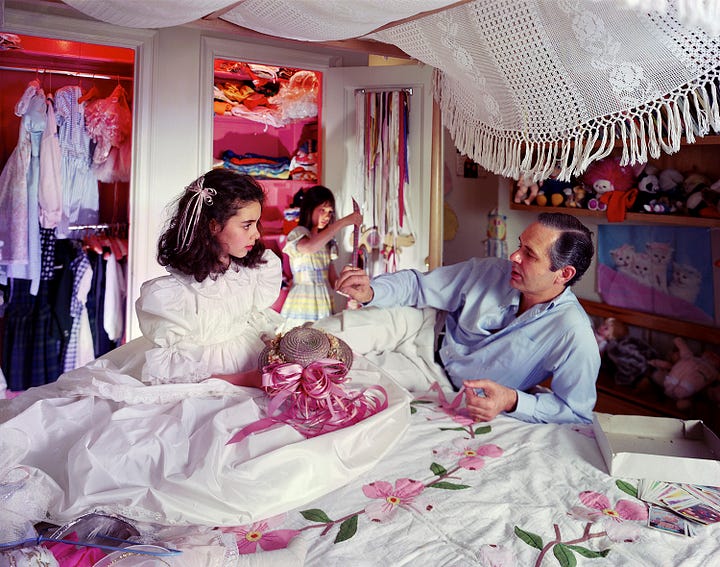
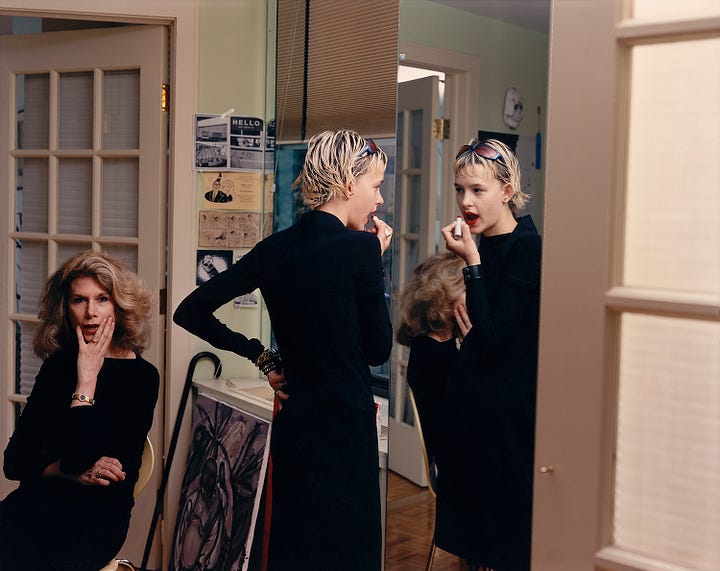
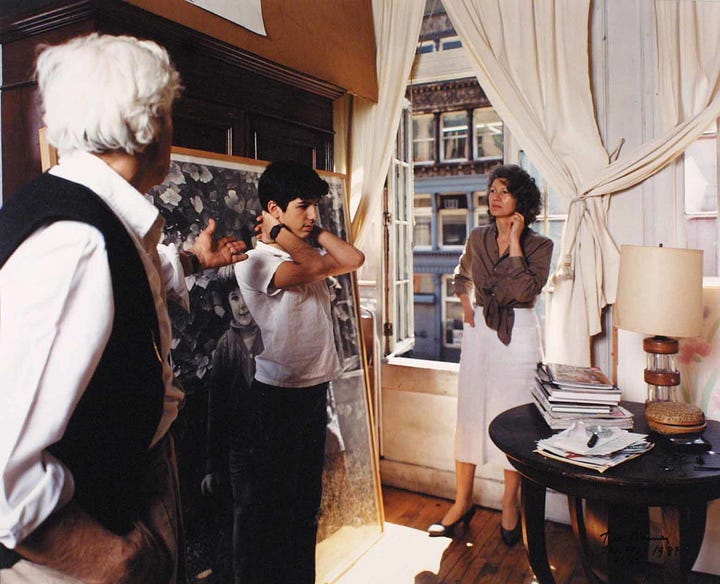
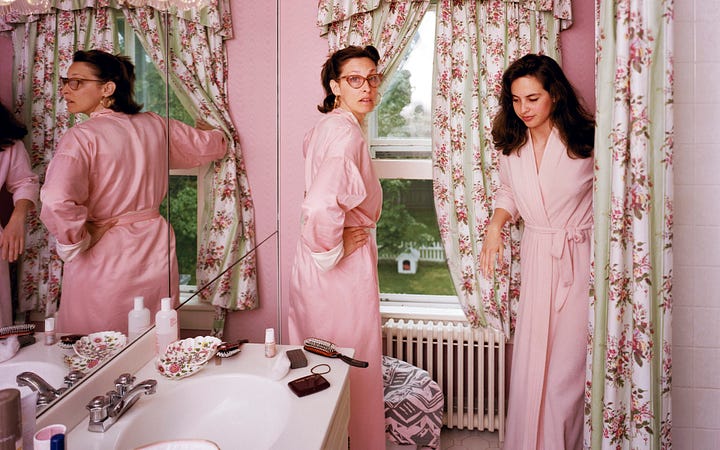
+ Abigail Heyman’s photo book Dreams and Schemes: Love and Marriage in Modern Times. Hard to find photos online, love this vid:
Movies: The Lady Eve, It Happened One Night, The Palm Beach Story, Sadie McKee, Something Wild, The Rules of the Game. At some point I made this small Lady Eve picture frame? Picture in a box? Not really a diorama. I think I needed to do something with my hands. Writing is hard :-)
Here’s a playlist that tells the same story to me…
Lastly, an influence in its haunting absence: There’s a lost silent film adaptation of Glimpses by Allan Dwan, from 1923. F. Scott Fitzgerald actually wrote the dialogue cards, it was one of his first jobs in Hollywood. (He wrote The Great Gatsby the following year, citing Dwan’s parties as an influence; we like to think Glimpses was, too.) Sam found some of the cheeky old marketing materials:
I’m sad we’ll never see this film, just this episode of Entourage:
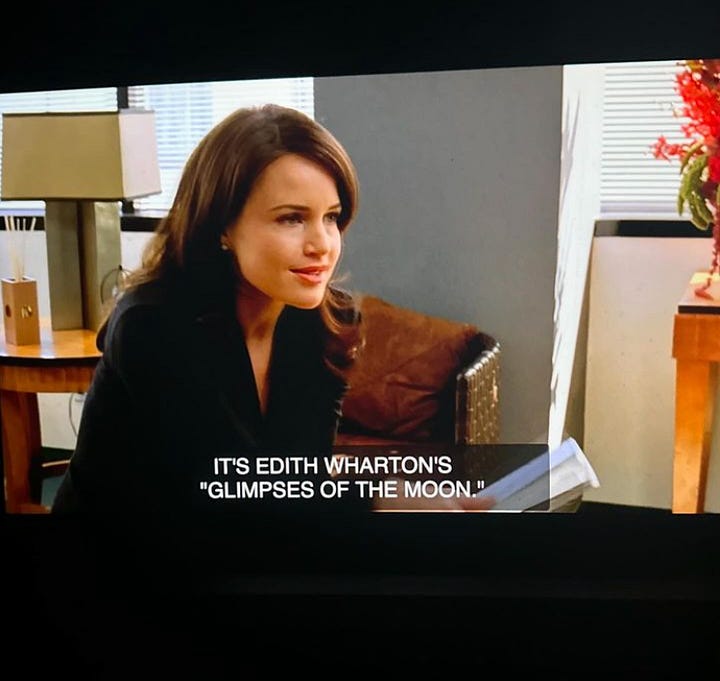



Directing
Directing the recording sessions = real “I can’t believe this is my job” days. I had not anticipated how much we’d be able to just focus on the performances without all the moving parts of a whole set. As an actor I am used to doing just a couple takes and the director being like “we got it <3” and me being like “the one where I was awful? Okay.” We had the luxury of getting really specific with everyone and getting lots of options, solely because our actors were so generous and totally spoiled us with their time and performances.
Adam plays our sweet and skeptical Nick. J. Smith-Cameron plays the narrator, who we wrote kind of as Wharton x Lynn Hirschberg. Both Adam and J do the thing I love from the book so well, their voices alternating swiftly between raising an eyebrow and really feeling for someone.
More riches: Gina Gershon as Susy’s mom (I know!!!), Arturo Castro, Talene Monahon. Playing multiple characters each: Jordan Carlos, Chloe Fineman, Ross Marquand, Cristin Milioti. Dumb fun: sending them vocal references. Magic: watching them do a bunch of different voices in a row. From G-Flip to Giuliani: A Life in the Booth.
Finally, Naomi Fry, Aminatou Sow, and Jia Tolentino all have cameos–very special given how much all of their writing and thinking have shaped my ideas about the internet, fame, etc. Spoiled, I say!
ANOTHER ROSE: Mumble’s post-production, and their gorgeous sound design, which really developed themes of the show in ways I couldn't have even anticipated, especially the differences in public and private spaces as Nick & Susy keep up their ruse. Thanks to Jake Young and Mumble’s whole team for being so precise and inventive. Mumble? More like NIMBLE!
(If anyone else is invested in things I’m learning it was also nice to be able to be that precise about timing in “post,” again because it was just audio. There isn’t a single “like” or “um” or pause that we didn’t very seriously consider! Also just loved directing myself and not feeling [as an actor] like there is a secret “correct” version of a character in the writer/director’s imagination that I am trying to imitate. Actually, I learned more concretely than ever that listening to myself as I went was Hell and made for worse performances, which I needed, because sometimes when I’m acting some part of me still thinks that controlling and judging myself throughout will somehow help. It…doesn’t. Sam could be our ears and then give me terrifyingly revealing notes, like “do it like when you complain about X thing” or “do it like when you complain about Y person.”)
So yeah it was literally Rumours!
Music
At first we were attached to using Irving Berlin’s “Always” but then Sam found sheet music for the 1923 film’s theme, which our composer Dylan Neely then adapted. Given the film’s lostness, it was amazing to hear it brought to life by Dylan and the musician Anneke Schaul-Yoder, Olivier Manchon, Kathryn Aldous, and Karen Waltuch.
Dylan’s whole score is one of my favorite things about this project. He captured so many hard tonal shifts and subtle genre allusions and (again, running theme) deftly alternated between wryly watching the characters and immersing us in their emotional landscapes.
Artwork
By Adrian Tomine! Feels like stating the obvious to elaborate on how good it is. Here are some of his sketches along the way. Plus it feels great to tell an actor that Adrian Tomine is drawing them, they get so excited!!!! (Adam was excited.)
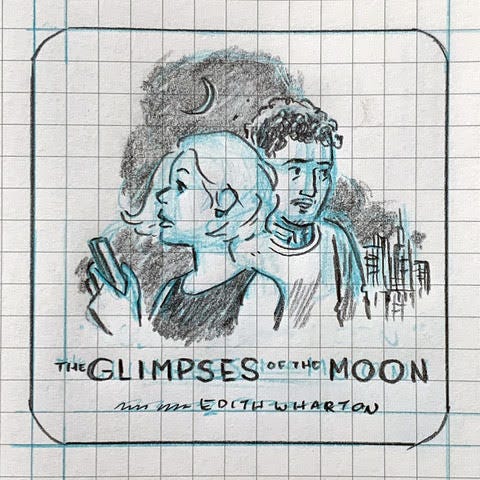
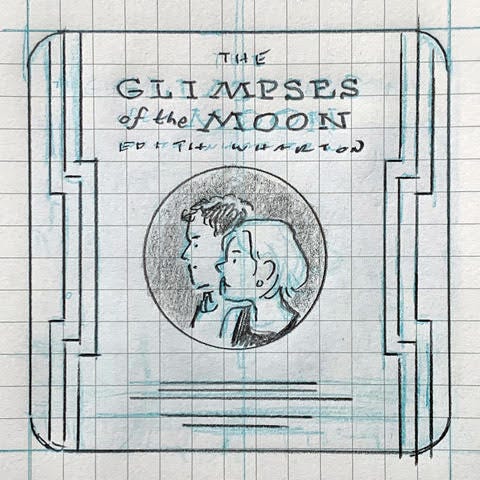
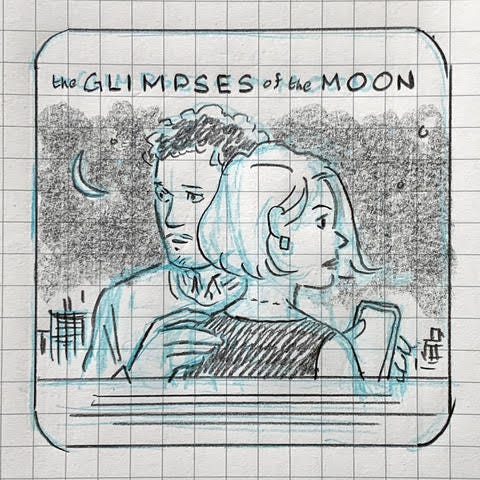

The End
And since this is now a…toast?, we are very grateful to our producer Ally Engelberg at Above Average, our producer Jessica Almon-Galland at Audible, and our friends Sam Bolen and Grace Madigan.
Thanks to Polyester Zine, Vogue, and Bullseye (out next month) for talking to me more about this project and Fan Fiction.
And thank you, reader-listener. We all have the history of everything at our fingertips at all times so I am DELIGHTED that anyone would put this on and have any reaction at all. Thank you, and I’ll see you in your mind’s eye…

